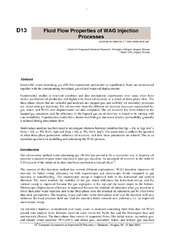Fluid Flow Properties of WAG Injection Processes
Chapter
Published version
Permanent lenke
https://hdl.handle.net/1956/5262Utgivelsesdato
2008-04-30Metadata
Vis full innførselSamlinger
Originalversjon
In: Proceedings : 13th European Symposium on Improved Oil RecoverySammendrag
Immiscible water-alternating-gas (IWAG) experiments performed on equilibrated fluids are summarised together with the corresponding two-phase gas-oil and water-oil displacements. Experimental studies at reservoir condition and also mechanistic experiments over many years have shown accelerated oil production and higher core flood oil recovery as a result of three-phase flow. The three-phase effects that are included and analysed are; trapped gas, and mobility for secondary processes (ex. water after gas injection). The oil recovery from the different oil recovery processes represented by; gas, water, and WAG core displacements are also compared. The oil recovery has been related to the trapped gas saturation, and the efficiency of the trapped gas on oil recovery is found to be varying with core wettability. Experimental results have shown that both gas and water relative permeability generally is reduced during three-phase flow. Multivariate analysis has been used to investigate relations between variables like Sgt = f(k, , Sgi, krwe), Sorm = f(k, WI, Sorw, Sgt) and Sorg = f(k, WI, Sorw, krge). The paper tries to address the question of what three-phase parameters influence oil recovery, and how these parameters are related. This is an important question for modelling and optimising the WAG process.
Beskrivelse
13th European Symposium on Improved Oil Recovery, Budapest, Hungary, 25. – 27. April 2005
